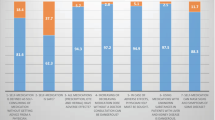Abstract
Objective We describe the development of a reliable and valid measure of people’s beliefs about self-medication. To achieve this, student self-medication beliefs and behaviours in response to acute pain were investigated. Specific objectives were to establish the internal reliability plus content and construct validity of this scale. Method The nine item ‘Self-Medicating Scale (SMS)’ was developed following one to one interviews conducted with a purposive sample of 10 lay people in 2001 to explore their self-medicating beliefs and behaviour. The SMS was completed by 304 undergraduate pharmacy students in March 2006, along with measures of self-reported over the counter (OTC) analgesic use, pain severity and other non-pharmacological methods of pain relief, using a cross-sectional design. Exploratory factor analysis was conducted on SMS items using Maximum Likelihood extraction and Varimax rotation. Main outcome measure Factor structure of the SMS and relationships between SMS scales and medication-taking behaviour. Results Factor analysis of the SMS revealed three factor structures which were named ‘Reluctance’, ‘Don’t think twice’ and ‘Run its course’ (each three item scales with good Cronbach’s alpha 0.82, 0.77 and 0.75 respectively). Of the 304 respondents, 93% reported having experienced pain over the past month and nearly three quarters of these indicated that they had self-medicated with OTC analgesics (mean 10.8 doses). Statistically significant differences or associations were found in all three SMS scores and each of the main outcome variables i.e. whether or not analgesics were taken, number of doses of OTC analgesics taken and number of non-pharmacological remedies tried. Conclusions These results show that the SMS possesses good internal reliability, plus good content and construct validity indicating that it is a useful measure of self-medication beliefs. More work is needed to extend these findings to the wider general public and with other OTC medications.
Similar content being viewed by others
References
The Wanless Report. Securing our future health: taking a long-term view. 2002. http://www.hm-treasury.gov.uk/Consultations_and_Legislation/wanless/consult_wanless_final.cfm. Accessed 17 Jan 2008.
Porteous T, Bond C, Hannaford P, Sinclair H. How and why are non-prescription analgesics used in Scotland? Fam Pract. 2005;22:78–85.
Wazaify M, Shields E, Hughes C, McElnay J. Societal perspectives on over the counter (OTC) medicines. Fam Pract. 2005;22:170–6.
Hammond T, Clatworthy J, Horne R. Patients’ use of GPs and community pharmacists in minor illness: a cross-sectional questionnaire-based study. Fam Pract. 2004;21:146–9.
Weinman J, Petrie KJ, Moss-Morris R, Horne R. The Illness Perception Questionnaire: a new method for assessing the cognitive representation of illness. Psychol Health. 1996;11:431–44.
Petrie KJ, Weinman J, Sharpe N, Buckley J. Role of patients’ views of their illness in predicting return to work and function after MI. Br Med J. 1996;312:1191–4.
Horne R, Weinman J. Patient’s beliefs about prescribed medicines and their role in adherence to treatment in chronic physical illness. J Psychosom Res. 1999;47:555–67.
Horne R, Graupner L, Frost S, Weinman J, Wright M, Hankins M. Medicine in a multicultural society: the effect of cultural background on beliefs about medications. Soc Sci Med. 2004;59:1307–13.
Paulose-Ram R, Hirsch R, Dillon C, Gu Q. Frequent monthly use of selected non-prescription and prescription non-narcotic analgesics among US adults. Pharmacoepidemiol Drug Saf. 2005;14:257–66.
Abbott FV, Fraser MI. Use and abuse of over-the-counter analgesic agents. J Psychiatr Neurosci. 1998;23:13–34.
Antonov K, Isacson D. Prescription and non-prescription analgesic use in Sweden. Ann Pharmacother. 1998;32:485–94.
Roumie CL, Griffin MR. Over-the-counter analgesics in older adults. Drugs Aging. 2004;21:485–98.
Turunen J, Mantyselka P, Kumpusalo E, Ahonen R. How do people ease their pain? A population-based study. J Pain. 2004;5:498–504.
Kelly E. Measuring patients’ preferred self-management approaches to minor illness. University of Brighton, MPharm project, April 2001.
French DP, James DH. Reasons for the use of mild analgesics among English students. Pharm World Sci. 2008;30(1):79–85.
Kline P. The handbook of psychological testing. 2nd ed. London: Routledge; 2000.
Ferrari A, Stefani M, Sternieri S, Bertolotti M, Sternieri E. Analgesic drug taking: beliefs and behaviour among headache patients. Headache. 1997;37:88–94.
Blenkinsopp A, Bond C. Over-the-counter medication. London: British Medical Association; 2005.
Isacson D, Bingefors K. Epidemiology of analgesic use: a gender perspective. Eur J Anaesthesiol Suppl. 2002;26:5–15.
Bingefors K, Isacson D. Epidemiology, co-morbidity and impact on health related quality of life or self-reported headache and musculoskeletal pain—a gender perspective. Eur J Pain. 2004;8(5):435–50.
Hannah L. Predictors of use of mild analgesics in a student population. Cardiff University, MPharm project, May 2006.
Acknowledgements
The data for this study were collected by Laura Hannah for her dissertation submitted in part fulfilment of her MPharm degree, Cardiff University (2006). The developmental work for the scale was undertaken by Emily Kelly for her dissertation as part requirement for her MPharm degree, University of Brighton (2001).
Financial support for the study
None.
Possible conflicts of interests
None.
Author information
Authors and Affiliations
Corresponding author
Rights and permissions
About this article
Cite this article
James, D.H., French, D.P. The development of the Self-Medicating Scale (SMS): a scale to measure people’s beliefs about self-medication. Pharm World Sci 30, 794–800 (2008). https://doi.org/10.1007/s11096-008-9227-2
Received:
Accepted:
Published:
Issue Date:
DOI: https://doi.org/10.1007/s11096-008-9227-2




